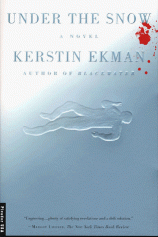Reading Group Guide
Discussion Questions
Under the Snow

1. Under the Snow is as much a murder mystery as it is a carefully crafted portrait of a small town. What kind of village is Rakisjokk? What effect has its near total isolation had on the people who live there? How do cultural differences between Samis and Swedes manifest themselves in this tiny town?
2. Matti’s frozen body is found in the dead of a sunless winter, and Torsson and David uncover the truth about his murder during the height of summer, a season which brings weeks of endless daylight to far northern Sweden. What role do the seasons play in Ekman’s narrative? How does she use light and shadow to tell her story?
3. Matti presented very different sides of himself to David and the people of Rakisjokk. Many in the town insist that David didn’t know the real Matti. What do we learn about Matti from these two camps? Is one version truer than the other?
4. When he first steps off of the ferry in Rakisjokk, David remarks that “you might think this is where the world comes to an end” (p.61). In many ways, the landscape of northern Sweden is an important character in the novel. What sort of character is the landscape and how does it shape the novel?
5. Kerstin Ekman wrote Under the Snow almost entirely in the third person except for Chapter 12, in which Matti’s killer explains how the murder was committed. Why do you think Ekman wrote the chapter this way? Does the device work? Who do you think the murderer is talking to?
6. Nearly everyone in Ekman’s novel has secrets. How do these secrets impact the characters’ relationships? Can we draw any universal conclusions about the nature of human ties from the relationships characters develop in Under the Snow?
7. On David’s first day in Rakisjokk, Vuori tells him, “Everyone who comes to the mountain, to stay, I mean, is usually turning their back on something. They all have something to get away from” (p.63). What does that assertion say about Matti’s decision to come to Rakisjokk, bringing Anna with him?
8. On pages 134-136, we learn about the passesadje in Sami religion. How does this particular myth relate to the novel as a whole? Are there other instances in Under the Snow in which myths come into play? What are their functions?
Under the Snow
- Publication Date: January 15, 1999
- Paperback: 224 pages
- Publisher: Picador
- ISBN-10: 0312200382
- ISBN-13: 9780312200381






